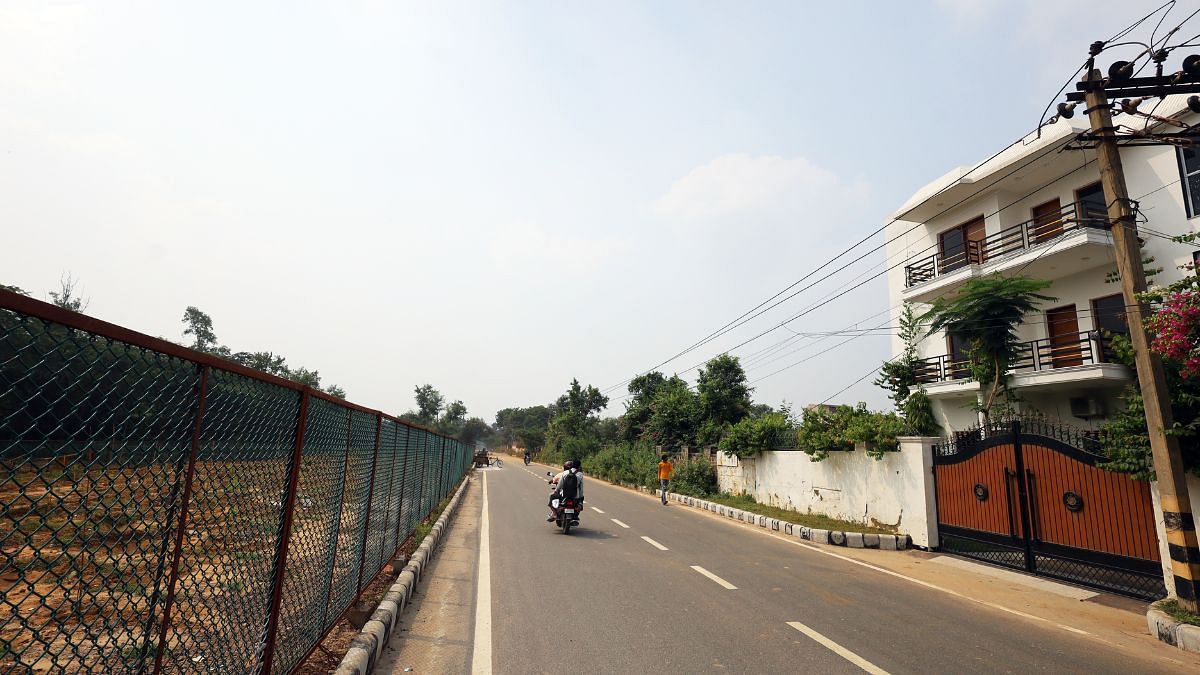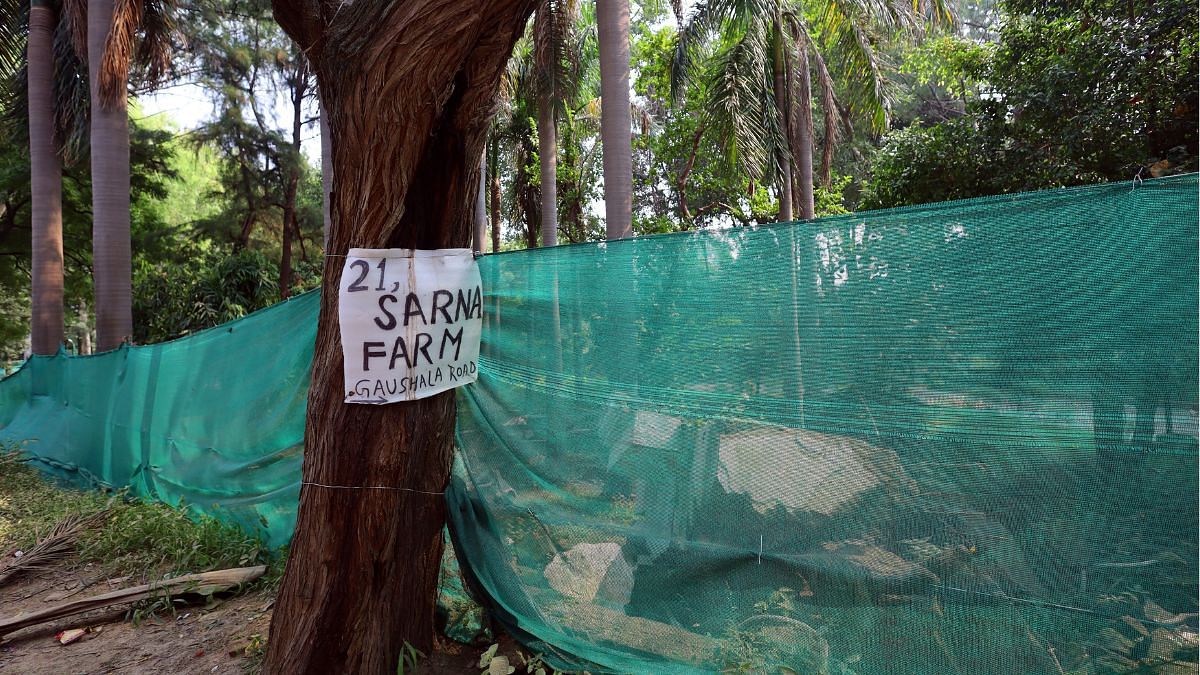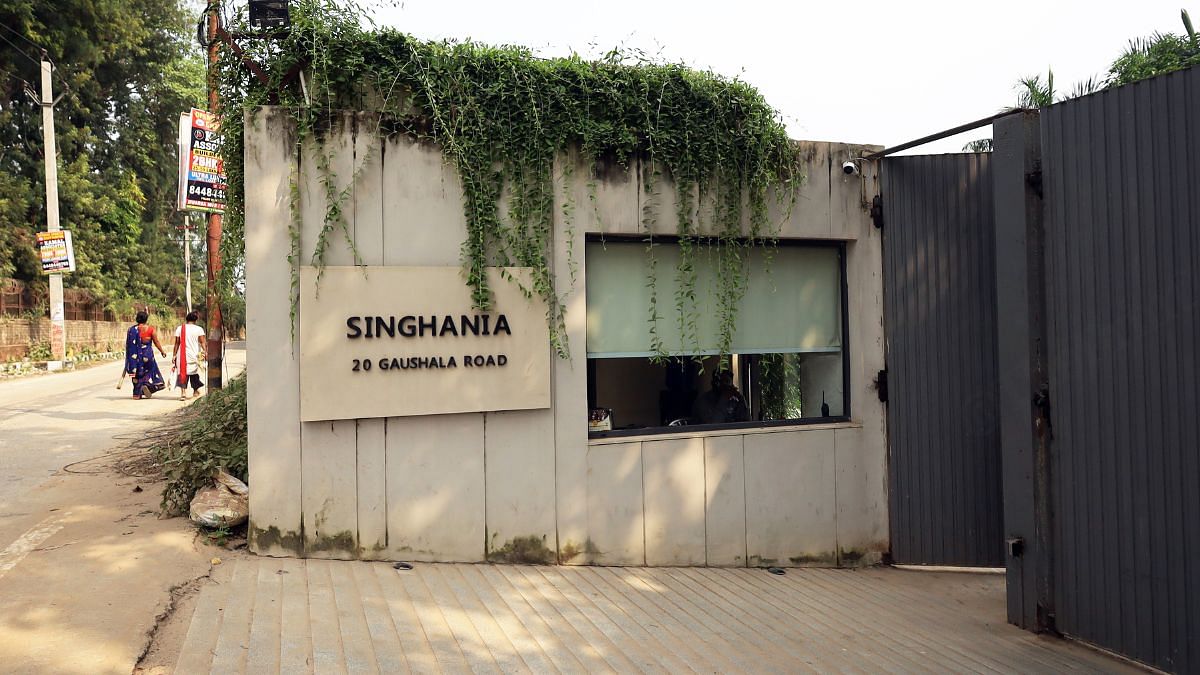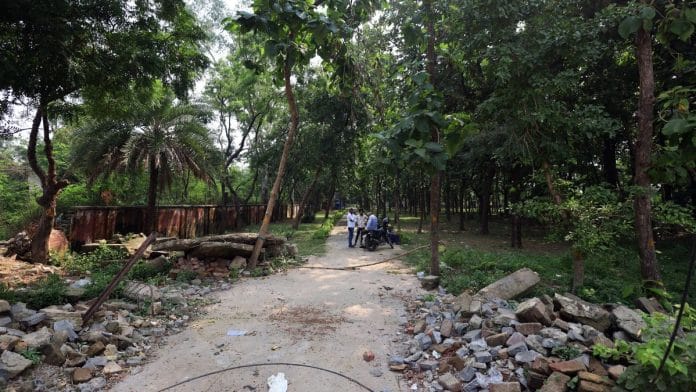New Delhi: About 4 km away from the busy Qutub Minar Metro station, a six-foot wire mesh fence is being installed along a 250-metre stretch of land in the Ridge area, adjacent to a narrow road in south Delhi’s Chattarpur. Inside the fence, saplings of native forest trees are being planted. Earlier this year, the Delhi Development Authority (DDA), the central government’s largest land-owning agency in the capital, had illegally cut down over 400 trees here.
The narrow stretch, around which all this activity is taking place, is the Gaushala Road. One of the most controversial roads in the capital, it has brought the DDA, the Delhi government, and Lieutenant Governor V.K. Saxena under the scrutiny of the Supreme Court.
It all began about 2 years ago when the DDA proposed an integrated road development plan to provide access to the new developments in the area. This plan included widening the 30-foot-wide Gaushala Road into a six-lane road.
Turning left from Chhatarpur Road leads to the narrow Gaushala Road. Along the first 1 km, the landscape on one side is lined with about half a dozen farmhouses, an ashram, and two small eateries. On the other side, there are three more farmhouses, some godowns, residential units, and a large stretch of forest land where the trees were felled.

In recent years, the area has seen significant development. The South Asian University (SAU) has been established, and the 950-bed Central Armed Police Forces Institute of Medical Sciences is complete but not yet operational. Additionally, residential accommodations for the National Investigation Agency (NIA) and Central Bureau of Investigation (CBI) are under construction in Maidan Garhi.
The contentious Gaushala Road is the shortest route connecting these developments to the rest of the city. However, with all the ongoing construction, the road is likely to become insufficient to handle the increasing traffic.
To address this, the DDA proposed the widening of the road. However, in its eagerness to execute the project, the agency in December 2023 went ahead and allotted land for the road expansion in the Ridge area, despite a Supreme Court order prohibiting land allocation for non-forestry activities. The Ridge is designated as forest land in Delhi.
That’s not all—the DDA also illegally felled over 400 trees on one side of the road without obtaining the necessary permission from the Supreme Court.
The proposed Gaushala-Rajur road widening project was to cover a 2.2 km stretch.
The DDA’s actions quickly drew the SC’s ire. Two different benches—one led by Justice B.R. Gavai and the other by Justice Abhay S. Oka—issued contempt notices against the Delhi L-G and the DDA vice-chairman for the illegal felling of trees in the Ridge area. Both the DDA and the Delhi government were reprimanded for violating the court’s orders.
Following a dressing down from the apex court, the DDA has started replanting saplings at the site.

It’s not only the apex court that has come down heavily on the Delhi L-G, DDA and Delhi government. Residents of the farmhouses on the side of Satbari Colony are leveling charges against the DDA for changing the road alignment to benefit some farmhouses on the other side. According to the residents of Satbari colony affected by the road widening project, the change in alignment has led to land being acquired only from one side of the road (where the colony is located).
Rajpal Tanwar, whose property in Satbari Colony is among those impacted, said, “Earlier, land for road-widening was to be taken from both sides of the road. But the DDA changed the plan later on and now the entire land will be taken from our side. This has been done to benefit people on the other side. Why did DDA change the plan?”
When ThePrint visited the spot Tuesday, a group of labourers were busy installing the wire mesh fence, while another group was planting saplings. “Work started in August last week. Close to 25 varieties of native forest trees are being planted here on court orders on the entire stretch of Gaushala road,” said a DDA official, who was supervising the work, to ThePrint on condition of anonymity.
ThePrint reached DDA via WhatsApp for a comment. This report will be updated if and when a response is received.
Currently, work on the controversial Gaushala-Rajpur project is at a standstill. The DDA cannot proceed with construction until it receives approval from the Supreme Court.
‘Plan changed to benefit some farmhouse owner’
Residents of Satbari Colony, located on the right side of Gaushala Road towards SAU University, blame the DDA for the chaos in the area. Both residents and owners of the three farmhouses are uncertain about their future as the road widening issue is still pending in court. Almost all of them have secured stay orders from the Delhi High Court after the DDA demolished the boundary walls of two farmhouses to allegedly clear land for the project.
While the DDA demolished the boundary walls of two farmhouses in October 2023 on one side of the road to facilitate widening, farmhouse owners on the other side continue construction activities in their premises unabated.
Satbari residents allege that the DDA has changed the original alignment of the road to benefit farmhouse owners on one side of the road.
For the road widening project, the DDA initially planned to acquire land from properties on both sides of Gaushala Road, as approved in 2022 by the Unified Traffic and Transportation Infrastructure (Planning and Engineering) Centre, the government body mandated to approve road infrastructure projects in Delhi. However, residents allege that the plan was changed to benefit the farmhouses on the other side of the road.
A resident of Satbari Colony, who has taken a stay order from the Delhi HC, told ThePrint, “We have the original drawings. But the DDA changed the plan and decided to widen the road from just one side.”
He claimed that the residents got to know about the change in plan last year in October when DDA came with bulldozers for demolition.
The blame game
In the past two years, ever since the road widening plan was finalised, new constructions in some of the farmhouses picked up pace on one side of the Gaushala Road, which has five to six farmhouses in a row. On the other side, where trees were felled, residents have not been able to even reconstruct the boundary wall of their farmhouses that was demolished by DDA last year.
Debris from the boundary walls remains at the entrance of two of the three farmhouses on the other side of the road, while construction continues at the farmhouse in front. At ‘21 Sarna Farms’, a green net used at construction sites has replaced the boundary wall that the DDA demolished in October last year. The two farmhouses with demolished walls are next to the forest land where the DDA felled trees.

In contrast, the third farmhouse, marked by a nameplate that reads “Singhanias,” was not affected by the DDA’s demolition efforts.

“The DDA just came and claimed the land belongs to them. They demolished the boundary wall without giving any prior notice. We have got the stay order against demolition from the Delhi High Court but we can’t reconstruct the wall…It is a major security issue,” said one of the affected farmhouse owners, who wished to not be named.
About 500 metres from Sarna Farms, new residential units have been built in one of the farmhouses that were not impacted by the road widening project. This property features residential units on the first floor and a café on the ground floor. A few metres away, a small grocery store has opened at the intersection of Gaushala Road and Rajpur Road, where SAU is located.
And, though locals are angry about the DDA’s change of plans without consultation with residents, they do admit that road widening is needed in the area, given the scale of development. They say they want the DDA to stick to the original plan, under which land was to be taken from properties on both sides of the 30-ft-wide road.
“We are not against widening of the road; we just want the DDA to follow the original plan,” said Rajpal Tanwar, a property owner who, along with other residents, had got a stay order from the Delhi HC against demolition action last year.
However, Mahesh Aggarwal, a farmhouse owner on the other side of the road that was not touched in the demolition, said he has no knowledge about DDA’s original road-widening plan.
Speaking to ThePrint, he said: “I bought this property just one-and-a-half-year ago. I’m not aware about the DDA’s initial plan under which land was to be taken from our property. I have constructed my house almost 30-foot from the main road. Whatever the government agencies decide, we will follow it,” said Aggarwal, a property dealer and consultant who is constructing a house on his farmhouse land.
What courts have said
Controversy also emerged in the Supreme Court during the hearing of the case, which was addressed by two separate benches. In July, Justice Gavai referred the issue to Chief Justice of India D.Y. Chandrachud to determine which bench should handle it. The matter is now before a three-judge bench led by the Chief Justice.
While the CJI-led bench is yet to decide as to which bench will hear the matter, the DDA last month began planting saplings on the stretch where trees were felled following Justice Abhay S. Oka’s order to restore the greenery.

In February 2023, Justice Gavai-led bench barred the DDA from allotting land for non-forestry activities. This order was to be in operation until further directions. It came pursuant to an application moved by DDA in which it sought permission for allotment of land in the Ridge area.
Despite the ongoing legal proceedings, the DDA allotted land in December 2023 for road widening in the Ridge and sought permission from the Supreme Court to fell trees. However, instead of approaching Justice Gavai’s bench, it filed its request with Justice Oka’s bench, that deals with unauthorised constructions, including encroachments, sealing, demolitions, and urban planning in Delhi.
While the matter before Justice Gavai’s bench remained pending, Justice Oka’s bench moved quickly, holding several hearings. During this process, it reprimanded the DDA and the Delhi government, demanding explanations for violating its earlier orders. It also sought explanation from DDA about Delhi L-G’s visit to the site days before trees were cut, and asked if it was done on L-G’s orders. In May, Justice Oka held the DDA vice-chairman in contempt for these actions, while a month earlier, Justice Gavai had also issued a contempt notice to the agency for the illegal felling of trees in the same area.
(Edited by Zinnia Ray Chaudhuri)






